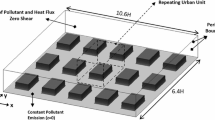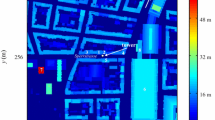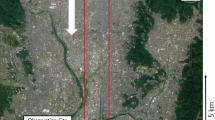Abstract
The influence of mesoscale circulations induced by urban-rural differential surface sensible heat flux and roughness on convective boundary-layer (CBL) flow statistics over an isolated urban area has been examined using large-eddy simulation (LES). Results are analyzed when the circulations influence the entire urban area under a zero background wind. For comparison, the CBL flow over an infinite urban area with identical urban surface characteristics under the same background meteorological conditions is generated as a control case (without circulations). The turbulent flow over the isolated urban area exhibits a mix of streaky structure and cellular pattern, while the cellular pattern dominates in the control case. The mixed-layer height varies significantly over the isolated urban area, and can be lower near the edge of the urban area than over the rural area. The vertical profiles of turbulence statistics over the isolated urban area vary horizontally and are dramatically different from the control case. The turbulent kinetic energy (TKE) sources include wind shear, convergence, and buoyancy productions, compared to only buoyancy production in the control case. The normalized vertical velocity variance is reduced compared to the control case except in the central urban area where it is little affected. The low-level flow convergence is mainly responsible for the enhanced horizontal velocity variance in the central urban area, while wind shear is responsible for the additional local maximum of the horizontal velocity variance near the middle of the CBL outside the central area. Parameterizations in the prognostic equation for TKE used in mesoscale models are evaluated against the LES results over the isolated urban area. We also discuss conditions under which the urban-induced circulations occur and when they may affect the entire urban area. Given that urban-induced circulations can influence the entire urban area within hours for an urban area of a realistic size, it is inappropriate to directly apply empirical relations of turbulence statistics derived under horizontally-homogenous flow conditions to an urban area.
Similar content being viewed by others
References
Albertson JD, Kustas WP, Scanlon TM (2001) Large-eddy simulation over heterogeneous terrain with remotely sensed land surface conditions. Water Resour Res 37: 1939–1953. doi:10.1029/2000WR900339
Angevine WM, White AB, Senff CJ, Trainer M, Banta RM, Ayoub MA (2003) Urban-rural contrasts in mixing height and cloudiness over Nashville in 1999. J Geophys Res Atmos 108(D3): 4092. doi:4010.1029/2001JD001061
Arakawa A, Lamb V (1977) Computational design of the basic dynamical processes of the UCLA general circulation model. In: Chang J (ed) Methods in computational physics, vol 17. Academic Press, pp 173–265
Arnfield AJ (2003) Two decades of urban climate research: a review of turbulence, exchanges of energy and water, and the urban heat island. Int J Climatol 23(1): 1–26. doi:10.1002/joc.859
Avissar R, Schmidt T (1998) An evaluation of the scale at which ground-surface heat flux patchiness affects the convective boundary layer using large-eddy simulations. J Atmos Sci 55(16): 2666–2689. doi:10.1175/1520-0469(1998)055<2666:AEOTSA>2.0.CO;2
Banta RM, White AB (2003) Mixing-height differences between land use types: dependence on wind speed. J Geophys Res Atmos 108(D10): 4321. doi:4310.1029/2002JD002748
Blackadar AK (1962) The vertical distribution wind and turbulent exchnage in a neutral atmosphere. J Geophys Res 67: 3095–3102. doi:10.1029/JZ067i008p03095
Briggs GA (1988) Surface inhomogeneity effects on convective diffusion. Boundary-Layer Meteorol 45(1–2): 117–135
Brown MJ, Williams M (1998) An urban canopy parameterization for mesoscale meteorological models. In: Proceedings of second symposium on the urban environment, Albuquerque, NM1998, American Meteorological Society, pp 144–147
Bryan GH, Fritsch JM (2002) A benchmark simulation for moist nonhydrostatic numerical models. Mon Weather Rev 130(12): 2917–2928. doi:10.1175/1520-0493(2002)130<2917:ABSFMN>2.0.CO;2
Cai X (1999) Large-eddy simulation of the convective boundary layer over an idealized patchy urban surface. Q J Roy Meteorol Soc 125: 1427–1444. doi:10.1256/smsqj.55615
Castro I, Cheng H, Reynolds R (2006) Turbulence over urban-type roughness: deductions from wind-tunnel measurements. Boundary-Layer Meteorol 118(1): 109. doi:10.1007/s10546-005-5747-7
Cheng H, Castro IP (2002) Near wall flow over urban-like roughness. Boundary-Layer Meteorol 104(2): 229–259. doi:10.1023/A:1016060103448
Chin HS, Leach MJ, Sugiyama GA, Leone JM Jr, Hoyt W, Nasstrom JS, Brown MJ (2005) Evaluation of an urban canopy parameterization in a mesoscale model using VTMX and URBAN 2000 data. Mon Weather Rev 133: 2043–2068. doi:10.1175/MWR2962.1
Ching JKS (1985) Urban-scale variations of turbulence parameters and fluxes. Boundary-Layer Meteorol 33(4): 335–361. doi:10.1007/BF00116683
Dalu GA, Pielke RA (1993) Vertical fluxes generated by mesoscale atmospheric flow induced by thermal inhomogeneities in the PBL. J Atmos Sci 50: 919–926. doi:10.1175/1520-0469(1993)050<0919:VHFGBM>2.0.CO;2
Deardorff JW (1980) Stratocumulus-capped mixed layers derived from a three-dimensional model. Boundary- Layer Meteorol 18(4): 495–527. doi:10.1007/BF00119502
Gopalakrishnan SG, Roy SB, Avissar R (2000) An evaluation of the scale at which topographical features affect the convective boundary layer using large eddy simulations. J Atmos Sci 57: 336–351
Grimmond CSB (2006) Progress in measuring and observing the urban atmosphere. Theor Appl Climatol 84(1–3): 3–22
Hadfield MG, Cotton WR, Pielke RA (1991) Large-eddy simulation of thermally forced circulation in the convective boundary layer. Part I: A small scale circulation with zero wind. Boundary-Layer Meteorol 57: 79–114. doi:10.1007/BF00119714
Hechtel LM, Moeng C-H, Stull RB (1990) The effects of nonhomogeneous surface fluxes on the convective boundary layer: a case study using large-eddy simulation. J Atmos Sci 47: 1721–1741. doi:10.1175/1520-0469(1990)047<1721:TEONSF>2.0.CO;2
Kanda M (2006) Large-eddy simulations on the effects of surface geometry of building arrays on turbulent organized structures. Boundary-Layer Meteorol 118(1): 151–168. doi:10.1007/s10546-005-5294-2
Kanda M, Moriwaki R, Kasamatsu F (2004) Large-eddy simulation of turbulent organized structures within and above explicitly resolved cube arrays. Boundary-Layer Meteorol 112(2): 343–368. doi:10.1023/B:BOUN.0000027909.40439.7c
Kustas WP, Albertson JD (2003) Effects of surface temperature contrast on land-atmosphere exchange: a case study from Monson 90. Water Resour Res 39: 1159. doi:1110.1029/2001WR001226
Letzel MO, Raasch S (2003) Large eddy simulation of thermally induced oscillations in the convective boundary layer. J Atmos Sci 60(18): 2328–2341. doi:10.1175/1520-0469(2003)060<2328:LESOTI>2.0.CO;2
Mayor SD, Spalart PR, Tripoli GJ (2002) Application of a perturbation recycling method in the large-eddy simulation of a mesoscale convective internal boundary layer. J Atmos Sci 59(15): 2385–2395. doi:10.1175/1520-0469(2002)059<2385:AOAPRM>2.0.CO;2
Mellor GL, Yamada T (1982) Development of a turbulence closure model for geophysical fluid problems. Rev Geophys Space Phys 20(4): 851–875. doi:10.1029/RG020i004p00851
Moeng C-H (1984) A large-eddy-simulation model for the study of planetary boundary-layer turbulence. J Atmos Sci 41: 2052–2062. doi:10.1175/1520-0469(1984)041<2052:ALESMF>2.0.CO;2
Moeng C-H, Rotunno R (1990) Vertical-velocity skewness in the buoyancy-driven boundary layer. J Atmos Sci 47(9): 1149–1162. doi:10.1175/1520-0469(1990)047<1149:VVSITB>2.0.CO;2
Morrison NL, Webster HN (2005) An assessment of turbulence profiles in rural and urban environments using local measurements and numerical weather prediction results. Boundary-Layer Meteorol 115(2): 223–239. doi:10.1007/s10546-004-4422-8
Moyer KA, Young GS (1991) Observations of vertical velocity skewness within the marine stratocumulus-topped boundary layer. J Atmos Sci 48(3): 403–410. doi:10.1175/1520-0469(1991)048<0403:OOVVSW>2.0.CO;2
Patton EG (1997) Large-eddy simulation of turbulent flow above and within a plant canopy. PhD dissertation, University of California, Davis
Patton EG, Sullivan PP, Moeng C-H (2005) The influence of idealized heterogeneity on wet and dry planetary boundary layers coupled to the land surface. J Atmos Sci 62(7): 2078–2097. doi:10.1175/JAS3465.1
Roth M (2000) Review of atmospheric turbulence over cites. Q J Roy Meteorol Soc 126: 941–990. doi:10.1256/smsqj.56408
Schmidt H, Schumann U (1989) Coherent structure of the convective boundary layer derived from large-eddy simulations. J Fluid Mech 200: 511–562. doi:10.1017/S0022112089000753
Shen S, Leclerc MY (1995) How large must surface inhomogeneities be before they influence the convective boundary layer structure? A case study. Q J Roy Meteorol Soc 121: 1209–1228. doi:10.1002/qj.49712152603
Spangler T, Dirks R (1974) Meso-scale variations of the urban mixing height. Boundary-Layer Meteorol 6(3–4): 423–441
Wang W (2009) The influence of topography on single-tower-based carbon flux measurements under unstable conditions: a modeling perspective. Theor Appl Climatol doi:10.1007/s00704-009-0130-0
Wang W, Davis K (2008) A numerical study of the influence of a clearcut on eddy-covariance flux measurements above a forest. Agric For Meteorol 148: 1488–1500. doi:1410.1016/j.agrformet.2008.1405.1009
Wong KK, Dirks RA (1978) Mesoscale perturbations on airflow in the urban mixing layer. J Appl Meteorol 17(5): 677–688. doi:10.1175/1520-0450(1978)017<0677:MPOAIT>2.0.CO;2
Xie Z, Castro I (2006) LES and RANS for turbulent flow over arrays of wall-mounted obstacles. Flow Turbul Combus 76(3): 291–312. doi:10.1007/s10494-006-9018-6
Author information
Authors and Affiliations
Corresponding author
Rights and permissions
About this article
Cite this article
Wang, W. The Influence of Thermally-Induced Mesoscale Circulations on Turbulence Statistics Over an Idealized Urban Area Under a Zero Background Wind. Boundary-Layer Meteorol 131, 403–423 (2009). https://doi.org/10.1007/s10546-009-9378-2
Received:
Accepted:
Published:
Issue Date:
DOI: https://doi.org/10.1007/s10546-009-9378-2




